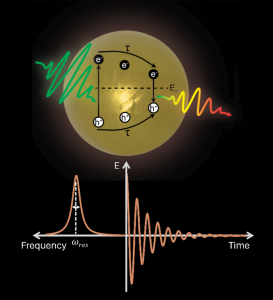
Light harvesting nanomaterials such as metals, doped semiconductors, and graphene-based structures can be optically excited to generate localized surface plasmon resonances. The collective electron oscillation dephases quickly on a few to tens of femtosecond timescale, characterized as an underdamped harmonic oscillator. Plasmon damping is separated into different contributions: the plasmon can re-emit photons (radiative damping), form electron-hole pairs (non-radiative damping), or interact with the adjacent medium at the interface (chemical interface damping, CID). Particularly, CID opens new and efficient pathways for plasmonic based structures to directly drive surface reactions by outcompeting internal relaxation on the same timescale. In order to manipulate the plasmon resonance according to its internal properties (material, size, shape) and unravel its interaction mechanisms with the adjacent external environment, it is important to understand plasmon and hot carrier decay dynamics.
We aim to study plasmon decay and hot-carrier transfer through frequency domain spectroscopy (dark-field scattering, photoluminescence, and photothermal absorption spectroscopy) on the single particle level to quantify each damping contribution. In parallel, our goal is also to visualize the hot-carrier dynamics through both ensemble and single-particle time-resolved spectroscopies (single-particle and ensemble transient absorption spectroscopy as well as single-particle luminescence upconversion spectroscopy. By taking advantage of plasmon resonance properties and especially its tunability to match molecular energy levels, our ongoing research has implications for photochemistry, photovoltaics, plasmon-enhanced emission, surface enhanced Raman scattering, and many other plasmon mediated physical and chemical processes.
Selected publications:
- W.-Y. Chiang, A. Bruncz, B. Ostovar, E. K. Searles, S. Brasel, G. V. Hartland, and S. Link, Electron–Phonon Relaxation Dynamics of Hot Electrons in Gold Nanoparticles Are Independent of Excitation Pathway, J. Phys. Chem. C, 127, 43, 21176–21185 (2023)
- S. A. Lee, B. Ostovar, C. F. Landes, and S. Link, Spectroscopic signatures of plasmon-induced charge transfer in gold nanorods, J. Chem. Phys., 156 (5), 064702 (2022)
- S. A. Lee and S. Link, Chemical Interface Damping of Surface Plasmon Resonances, Acc. Chem. Res., 54 (8), 1950 (2021)
- B. Foerster, V. A. Spata, E. A. Carter, C. Sönnichsen, and S. Link, Plasmon damping depends on the chemical nature of the nanoparticle interface, Sci. Adv., 5 (3), (2019)
- B. Foerster, A. Joplin, K. Kaefer, S. Celiksoy, S. Link, and C. Sönnichsen, Chemical Interface Damping Depends on Electrons Reaching the Surface, ACS Nano, 11 (3), 2886 (2017)

